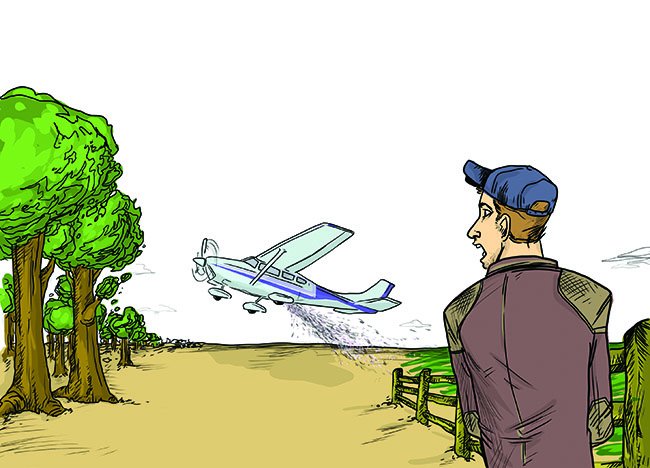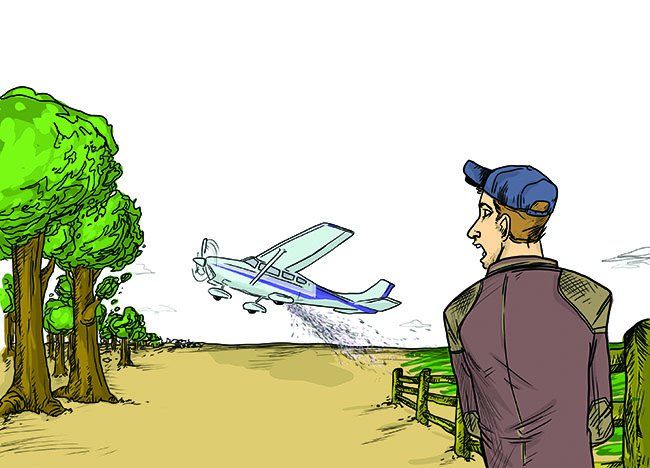If you’ve been with us a while, you’ll recognize our yearly foray into the bent and bizarre culled from a year’s worth of NTSB accident summaries (all non-fatal, of course). Not all are actually stupid. Some are just plain, er, strange. But all, we think, are worthy of note. Each year offers up those who think too much, those who think too little and those who don’t think at all.
This installment is from accidents reported in the year 2006.

Unconcerned with Details
And failure to act on knowledge can cost you power. Like the pilot of a Beech Bonanza cruising near Peoria, Ill., who reported a rough running engine and oil on the windscreen. He ultimately made a successful forced landing in a corn field with the engine on fire. Inspection revealed the number five piston and environs all but disintegrated.
This might seem like slick piloting, until you discover that the aircraft records included an oil analysis report saying: “CAUTION!!!!!***EXTREME NICKEL CONCENTRATION. HIGH CONCENTRATIONS OF NICKEL ARE CAUSED BY VALVE GUIDE WEAR. CONTACT THE ENGINE MANUFACTURER’S SERVICE REP. RESAMPLE IN 25 HOURS.” All those exclamation points would get our attention, but the intrepid owner did nothing—for the next two years and almost 200 hours.
Consider, as well, the California pilot of a Cesssna 150 operating over Humboldt Bay who said his engine started to “fade out.” The pilot reported applying carburetor heat without success until the engine quit graveyard dead. Restart was unsuccessful and the pilot conducted a “standard water landing” in about 12 feet of water.
First off, we’d like to see what a “standard water landing” in a 150 looks like, but it gets much, much better.
During the investigation, the FAA rep checking out the recovered aircraft noted an overall condition of poor maintenance, including a placard stating the carb heat was inoperative. You know, the carb heat the pilot said he applied. Then there were little details like the fact that the last recorded annual was accomplished 16 years earlier. Not to worry, however, as the pilot reported that he did the maintenance on the aircraft, albeit without the pesky detail of having actually acquired an A&P certificate. The pilot’s medical was six years old and no record of a BFR existed, but that’s OK, too. According to the pilot, the real cause of this accident was that his weather briefing (from an unspecified source) didn’t include a temperature and dewpoint report.
Taking on New Challenges
Most people find the tummy-rubbing, head-patting aspects of helicopter flying sufficiently entertaining by themselves, but not the Louisiana pilot who tried to land his R-44 on a wheeled landing cart designed to move it in and out of the hangar. Problem was, no tractor was attached and the wheels hadn’t been chocked. After touchdown, the helpful little cart rolled toward the hangar and the rotor blades diced metal before the pilot could shut it down. Ya reckon, “Landing on Large Roller Skate,” should be added to the rotorcraft Practical Test Standards?
It’s not uncommon for folks to buy an airplane and immediately launch into the ether without any dual in same. But the Virginia pilot who balled up his new Tri-Pacer elevated this to a whole new level. Not only had he received no instruction in the new plane, he had received no brush-up dual in anything—and his last logbook entry was in 1979.
Even worse, was the New York owner/builder of a small jet who launched the shiny new toy on its maiden flight with no prior time in a jet. Zip. Nada. None. The initial climb was estimated by witnesses at 4000 to 5000 feet per minute and the NTSB says it exceeded 200 knots on the downwind. With power reduced to flight idle for approach, it got low and slow and then wouldn’t spool back up, winding up as an very expensive lawn dart 100 feet short.
On the subject of challenges, the Arizona CFII instructing in a Seminole might have taken it just a teensy bit too far. During a practice instrument approach, the instructor simulated feathering by reducing the right engine to 11 inches of manifold pressure and had the student continue the approach visually. About 20 feet from touchdown, the double-I made things more interesting by pulling both throttles to idle. When they bounced, the instructor ordered a go around, but the right engine never regained power and, below minimum controllable airspeed for the twin, the inevitable rollover occurred, fortunately with only minor injuries. When maintenance technicians arrived they found that the right fuel flow had been turned off.
We also always find at least one cautionary example that 10,000 hours doesn’t really make you Chuck Yeager. Witness the Denver pilot who decided to haul a 172 aloft in winds of 25G34. Lined up perpendicular to the wind for run-up, the pilot extended the flaps as specified in the checklist (which presumably came from the same POH that gave a demonstrated cross-wind component about half what was being reported). At that point, the winds spun the Skyhawk another 90 degrees and flipped it on its back.
We’ve never really understood the folks who short-circuit procedures just to save a few minutes of what we all supposedly enjoy so much. One Kentucky Taylorcraft pilot decided to land by “cutting” between some trees, an approach he knew was “bad” but the taxi time to his parking space was less from that direction. Serious injury and substantial damage resulted. Wonder how much extra time that took?
Flying Down the Rabbit Hole
Some accidents are just odd. Remember President Carter’s killer rabbit sideshow? Apparently the bunny’s evil twin migrated to North Carolina and balled up the landing gear of an RV-6 and wrecked the landing. Spend much time in the accident summaries and you’ll come away with a healthy respect for Bambi, but now we gotta start watching for Thumper, too.
Scheduled service isn’t immune from our review. A Michigan station agent discovered a baby stroller that had been missed during loading of a Saab 340 (turboprop twin). The pilot shut down the left engine while the agent opened the cargo compartment at the left rear and let go of the stroller. The stroller landed on its wheels and was blown under the fuselage into the right main landing gear, then careened off that into the right propeller arc, whereupon puree of stroller punched several holes into the fuselage. Oops.
Always on the lookout for new vistas of “You Gotta Be Kidding Me,” we found the California U206G pilot who was spreading “sterile, pink, bollworm moths” on several cotton fields. We’ll pause here a moment while you consider the visual on that.
Nature called and the pilot landed to respond to same, leaving the 206 running while he visited the nearby restroom facility. While inside attending to business, the pilot reported hearing the parking brake disengage and the RPMs increase. In the words of the report, “As he chased after the airplane, he watched as the airplane hit a bump, turned 120 degrees to the left, went down the ramp at the end of the field, through the airport perimeter fence, hit a street sign, went over two roads, and came to rest on an almond orchard embankment.” Maybe the almond trees needed some pink bollworms, too.
Getting lost is too routine to be fun unless you’re the Texas pilot of a Wilga—that funky-looking utility aircraft with the praying mantis landing gear—who lost positional awareness while dead reckoning (sans chart) during a cross-country. When fuel started looking dodgy, the pilot landed, then figured out he was 200 miles south of his intended destination, inside Mexico. Probably yelling “Ay yi yi” instead of “Clear,” he took off again, heading north “until he spotted a Texas flag.” Even lower on fuel now, the resulting precautionary landing didn’t turn out all that well. But at least he didn’t wind up in La Casa Grande.
A Hearty Hail and Farewell
And last but hardly least, perhaps you’ll pardon a bit of a departure. The accident itself wasn’t noteworthy, involving an entirely successful ditching after engine failure in the Virgin Islands. What caught our attention, however, was that the involved aircraft was a DC-3 returning to San Juan from delivering the U.S. mail to the Virgin Islands. No Basler conversion, here. No turbine intakes. No museum logo. Just a rugged old bird still sporting the early Wright R-1830 Cyclone engines, earning her way in regular commerce after 60-odd years.
She saw combat in WWII and was on the flight line for the CIA. She flew in Saudi Arabia and Malaysia as well as the U.S. and the Caribbean. Now she’ll shelter fish and teach wreck divers a thing or two. We thought she was worth a passing salute.
Jane Garvey is a long-time IFR contributing editor.





